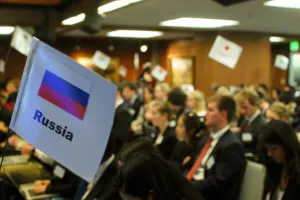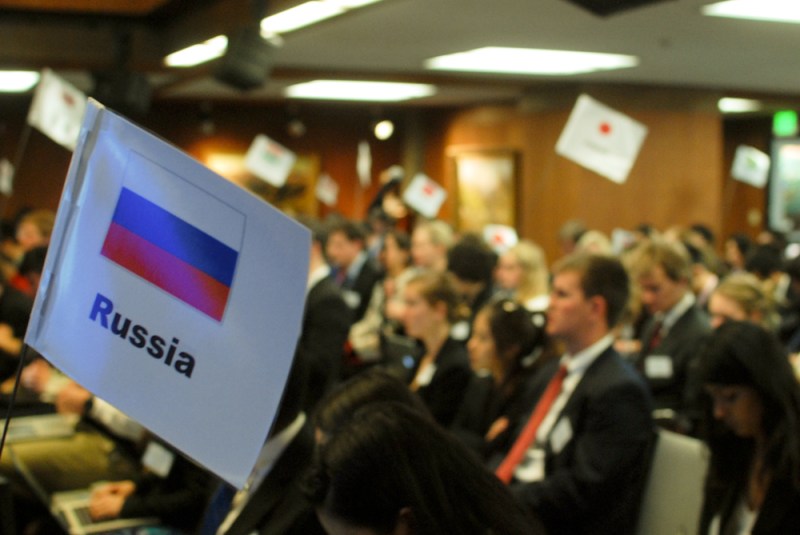“As a permanent member of the United Nations Security Council [UNSC], the delegation of France formally requests that Israel join the [Nuclear Non-Proliferation Treaty],” the delegation chair of the French Republic said.

Gasps rose from delegates at the emergency UNSC session as the American delegation huddled urgently outside. Called to speak by the chair, the Americans rushed to the lectern as foreign delegates scrambled to find out exactly why the world’s western powers had demanded transparency from the Israeli nuclear program.
Of course, no such demand actually came from France over the weekend. The proceedings were part of the Polisci 114S: International Security in a Changing World class simulation of the UNSC, where for 48 hours students transformed into delegates debating one of today’s hottest international issues: the Iranian nuclear program. The French Republic delegation chair who requested that Israel ratify the treaty was Robert Chun ’16.
Scott Sagan, professor of political science and creator of the class’s first simulation 16 years ago, characterized the simulation as evolving into a “more realistic learning experience,” especially given the rapidly changing and increasingly precarious international security climate of recent years.
“This year’s simulation is taking place in a real-world situation that is very dynamic,” Sagan said. “It’s very hard to tell sometimes when there’s an announcement whether this is something that has been simulated or whether it’s something that has really happened.”
Realism was a key goal of not only the simulation — which course teaching assistant Eric Min, a second-year graduate student, described as “the highlight of the course” — but of the class as a whole, which was meant to be a wide-ranging view of current international security issues.
“The idea of the simulation is twofold,” said Hoover fellow Amy Zegart M.A. ’93 Ph.D. ’96, who teaches the course. “We want to give students a real feel for international relations, [and] we want them to realize how much in the real world involves dealing with the unexpected, which is not what you often find in college classes. You understand why those seemingly obvious answers don’t happen in real life.”
To achieve realism, students participating in the simulation were required to do everything from memo drafting to press coverage.
“The most challenging part is for students to write an executive memorandum, which is an invaluable skill in real life,” said course teaching assistant Arash Aramesh J.D. ’14.
For the second year in a row, students in the Department of Communication acted as members of the international press corps covering the simulation. Students in Comm 104W: Reporting, Writing, and Understanding the News, taught by lecturer in communication and former Washington Post Jerusalem Bureau Chief Janine Zacharia, imitated real reporters, asking questions at press conferences and releasing news blasts throughout the simulation.
Ruth Bram ’14, a member of the press corps, found herself thrown quickly in the drama of the simulation.
“You have to be very quick on your feet and decipher in just a few seconds what is newsworthy or not,” she said. “We’re not only informing the public but also the delegates about what’s happening in their own summit.”
Zegart commented on how quickly things change in geopolitics, with changes on one side of the planet affecting negotiations on the other.
“Things get very interesting very fast,” she said. “You have delegates hacking into other delegates’ email accounts, heads of state getting executed, delegations walking out in protest. It’s all very dynamic.”
This year, nuclear weapons were tested in North Korea during the proceedings, and the king of Saudi Arabia died from food poisoning. Delegates were also notified — in a case of apparent email hacking — that Israeli forces had attacked Italy.
While that dynamism may be faculty-initiated, simulation organizers insisted that the ensuing developments are student driven.
“We inject surprises during the course of the simulation just to keep students on their toes,” said Martha Crenshaw, course professor and senior fellow at the Center for International Security and Cooperation. “At the same time, we are careful not to add too much to the scenario, because a lot of it is about students reacting, talking to other delegations and working through the developments. We let them take the lead.”
The simulation has grown over the last few years, with student participation tripling this year.
“This is by far the most elaborate simulation I’ve ever seen — we have 12 to 15 faculty acting as heads of state and 170 students representing 23 countries,” Zegart said.
Crenshaw commented on how the simulation can be a deeply immersive and sometimes even emotional experience for students.
“In the past years we’ve seen students become so immersed in reaching a compromise that they were furious when their resolution was vetoed,” she said. “Students remember this simulation for years afterwards.”
Rehan Adamjee ’16, chair of the North Korean delegation, said playing characters in simulation expanded his knowledge far beyond what he might hear in the news.
“I really learnt to be [North Korea],” he said, referring to the oft-unpredictable and provocative regime.
Cameron Hutton ’14, who represented Argentina, said the experience was “fantastic” but left room for improvement.
“Maybe having more countries would make this even more representative of the UNSC,” he said.
